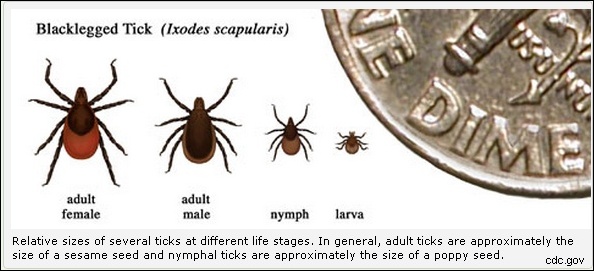
6 April 2012
Word on the street is: It’s going to be way too easy to catch Lyme disease this year. That’s because it’s a boom year for black-legged ticks (also called deer ticks) and a bust year for their preferred blood host, white-footed mice. Since mice are scarce the ticks will look for other hosts including us and our pets.
Lyme disease is caused by a bacteria (Borrelia burgdorferi) transmitted by the bite of a black-legged tick. Black-legged ticks must have a blood meal in order to transition to their next life stage. Any tick that’s acquired the bacteria from a prior host will give the bacteria to its next host.
The nymph stage is the most dangerous to humans because it is so hard to see. It’s a critter the size of a poppy seed that has all the time in the world to walk up your body in search of a sneaky place to latch on and suck your blood. If it bites you for more than 24 hours you have a higher chance of getting Lyme disease.
You never, ever want to get Lyme disease. As my friend Dick Martin says: “About a week after the infection, you will be hit by instant old-age. Aches, flu-like symptoms, etc. are bad. I speak from experience.” The disease is debilitating with life-long effects if you don’t catch it early.
It’s way too easy to pick up ticks during any one of these activities:
- Unwittingly visit infested areas (notice red X’s at this link). Interestingly, the infection zones for Pennsylvania are more widespread than the tick infestation map.
- Sit down outdoors on anything other than pavement or furniture.
- Walk off trail near a stream, seep or wet zone.
- Step into leaf litter.
- Allow grass or plants to brush against you.
So you shouldn’t go outdoors? Wrong! Your best defense is vigilance:
- Wear light-colored clothing that covers your skin — long pants and a long-sleeved shirt with collar. Pull your socks over your pant cuffs. I can tell you this outfit is eccentric and stifling in hot weather but it’s worth it.
- Spray your clothing with bug repellent, especially your boots, socks, pants. Read about what to use here: Today Is Spray Your Clothes Day.
- Check for ticks. Check your clothing while you’re in the woods. (That’s why you wear light colors.) Check before you get in your car. Check your body and scalp (take a shower).
- Remove ticks with precision tweezers.
- Know Lyme disease symptoms and get treatment early. Dick Martin says, “Don’t count on the bull’s-eye red rash; I skipped that indicator. If you pick off a blood-filled tick, ask your doctor for a prophylactic dose of an approved medication. If you hesitate for the week, you have a tougher regimen of medication. If you somehow ignore that, you have more serious, long-lasting effects.”
Read here for more information on black-legged ticks and Lyme disease.
Hawaii is the only state where Lyme disease has never been reported. Plan accordingly.
(image from CDC.gov. Click on the image to read more about black-legged ticks and Lyme disease)
That did it, I’m moving to Hawaii.
Great article! I am glad you have a link about tick removal, which includes this:
Use fine-tipped tweezers…
Avoid folklore remedies such as “painting” the tick with nail polish or petroleum jelly, or using heat to make the tick detach from the skin. Your goal is to remove the tick as quickly as possible–not waiting for it to detach.
Last was the first year that we’ve ever had serious problems with finding ticks on us while we were hiking. If you do any deep woods hiking, it’s nearly impossible to avoid places where they are commonly found. Around here we generally see the smaller black ticks, but last summer when we were in North/Central PA, we were finding huge brown ticks on us after hiking (close to a centimeter long). I was just pulling them off with my fingers they were so big. Really disgusting. We have not resorted to insect repellent on the clothing thus far, but I think we’re going to have to go that route this year.